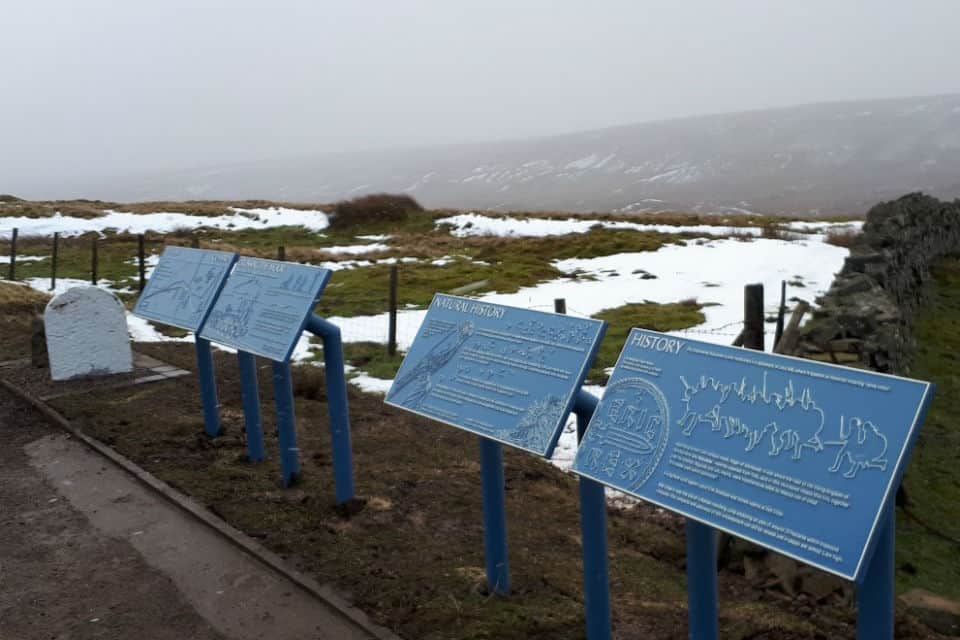Highways England has reached a major milestone in a £5.2 million programme of environmental improvements across the North West – by restoring actual historic milestones.
The company, which runs the country’s motorways and major A roads, signed off the five-year programme of biodiversity, landscaping and heritage works a few weeks ago by finishing work in a lay-by along the westbound A66 right on the ancient border between Cumbria and Durham.
The ancient marker stone (foreground) – before its renovation and relocation elsewhere on the site – is pictured alongside the A66 right on the historic border between Cumbria and County Durham.
In a real hands-across-the-Pennines moment, the work has transformed the rather non-descript resting area near Stainmore into a visitor stop-off in its own right, complete with renovated historic marker stone and four new display boards chronicling both the human and natural history of the area.
The renovated and re-positioned marker stone (left of picture below) plus new information board chronicling the history of the border area has transformed this layby along the A66 near Stainmore
Highways England project manager Dion Auriac said:
“Our motorways and major A roads are the arteries of the economy – keeping businesses, commuters, tourists and goods and services on the move. However, we’re determined to minimise the impact of our roads on the environment and enhance their surroundings where possible.
“At Stainmore we’ve improved the experience for drivers taking a quick break and better acknowledged the significance of this gateway location – and it’s just one of dozens of improvements we have or will be delivering across Cumbria and North Lancashire in a ten-year period.”
 Work at the layby, in the North Pennines area of outstanding natural beauty (AONB), is part of a wider package of projects from a special ring-fenced ‘designated fund’ for environmental improvements in the Government’s road investment strategy (RIS) which began a second five-year programme in April.
Work at the layby, in the North Pennines area of outstanding natural beauty (AONB), is part of a wider package of projects from a special ring-fenced ‘designated fund’ for environmental improvements in the Government’s road investment strategy (RIS) which began a second five-year programme in April.
The same fund has helped Highways England support the high profile Get Cumbria Buzzing campaign to breathe new life into roadside verges as well as a host of other initiatives across three biodiversity, landscaping and heritage strands. Over the past five years the work has included:
• The biodiversity work helping transform roadside verges and boost pollinator habitats through better stewardship and native species planting – the programme including supporting Cumbria Wildlife Trust’s Get Cumbria Buzzing initiative along the A595 and A66; a species-rich grassland project along the M6 from Preston up to the border with Scotland; and working with partners in the A590 Morecambe Bay nature improvement area (NIA) to help enhance and restore 13.5 hectares of roadside vegetation with insect, butterfly and reptile habitats benefiting as much as bees.
An investment in biodiversity along the region’s major A roads and motorways is helping to boost native plant and wildlife..
• Work to improve cultural heritage along the A66 including enhancing the environment around local landmarks like the 17th century octagonal sandstone Countess Pillar near Penrith and the iron age Castle How Hillfort on the western shore of Bassenthwaite – as well as replacing a missing 19th century milestone near Whinfell Park and restoring a second historic – and heritage listed – milestone near Crackenthorpe Hall.
Above: Funding for local heritage has improved the visibility of Countess Pillar which is alongside the westbound A66 at Brougham near Penrith. The scheduled ancient monument (SAM) and Grade II* listed building is a 17th century octagonal sandstone pillar commissioned by Lady Anne Clifford in 1656 in memory of her mother, Margaret Clifford, Countess of Cumberland. The top of the monument is highly decorated, painted in bright blue and gold with sundials on several of its sides.
Below: Also as part of the heritage work a missing 19th century milestone near Whinfell Park has been replaced with a faithful replica where it stood in the verge along the eastbound A66 east of Penrith. The original milestone was a sandstone block encased in cast-iron and a suitably qualified conservator helped provide the replica using another local milestone as a template.
• Landscaping to help enhance Cumbria’s tourism ‘offer’ including the work at Stainmore layby and another A66 layby at Troutbeck west of the M6 at the gateway to the Lake District National Park and world heritage site. Views from the layby open towards the Lakeland high fells and a general layby enhancement and biodiversity improvement project has included cleaning and tidying up the layby and verge, wildflower seeding and planting of heather and bilberry as well as planting birch, holly, hazel and elm trees.
The completion of the environmental projects in the North West is being celebrated as Highways England announced plans last week to pump £936 million into its designated funds programme over the next five years between 2020 and 2025. The money will support work – often delivered in locally-based partnerships and driven by local people’s priorities – to improve the environment along roads, give a better deal for pedestrians, cyclists, and horse riders, tackle air and noise pollution and look at innovative ways of delivering a better strategic road network for everyone.






